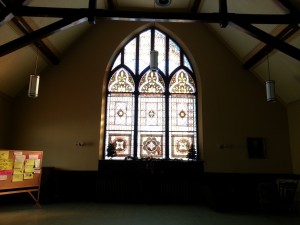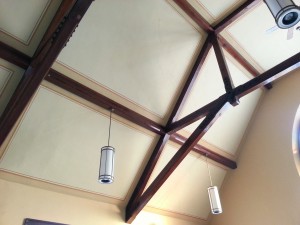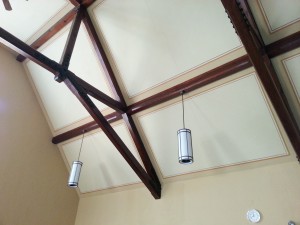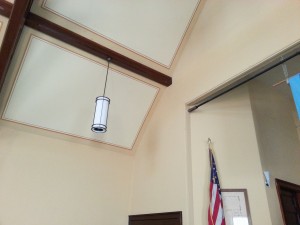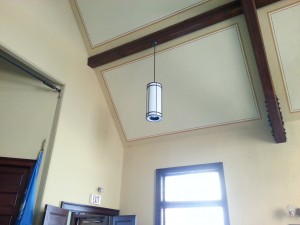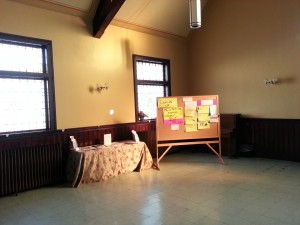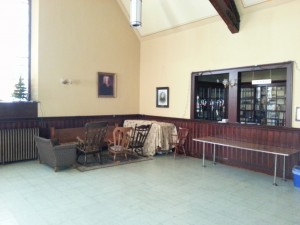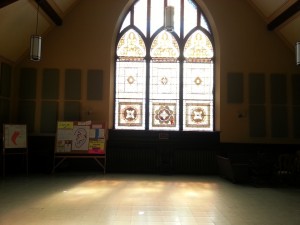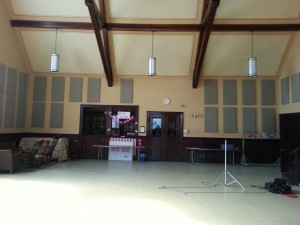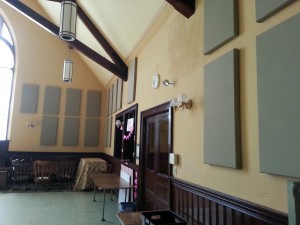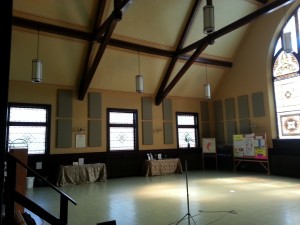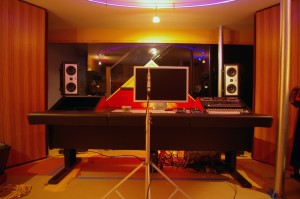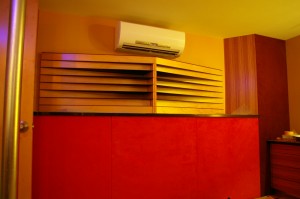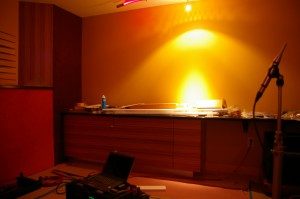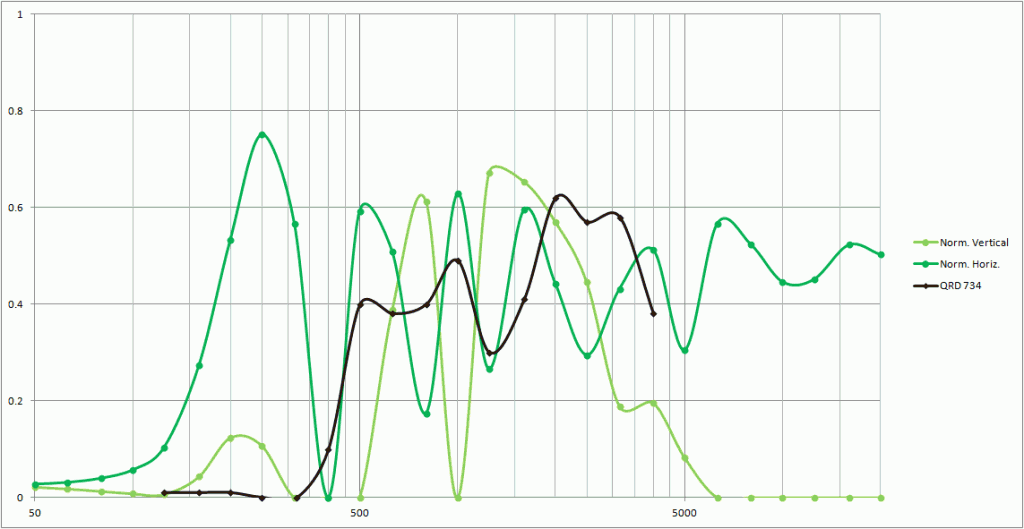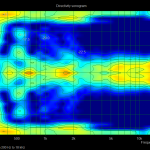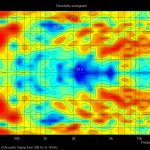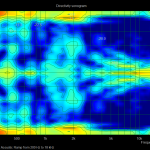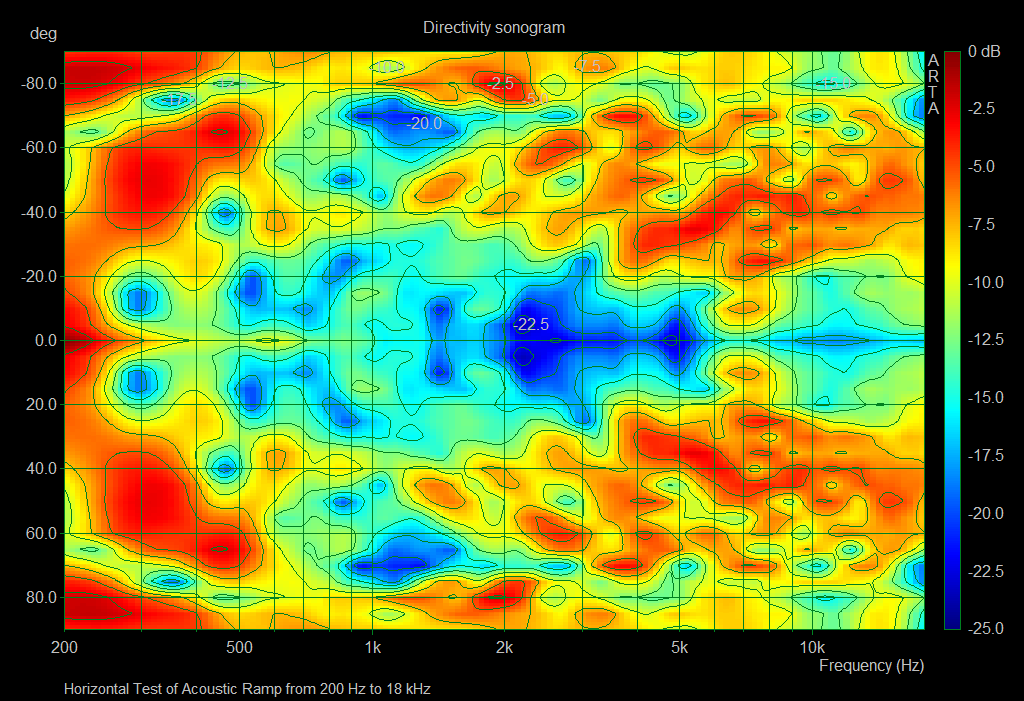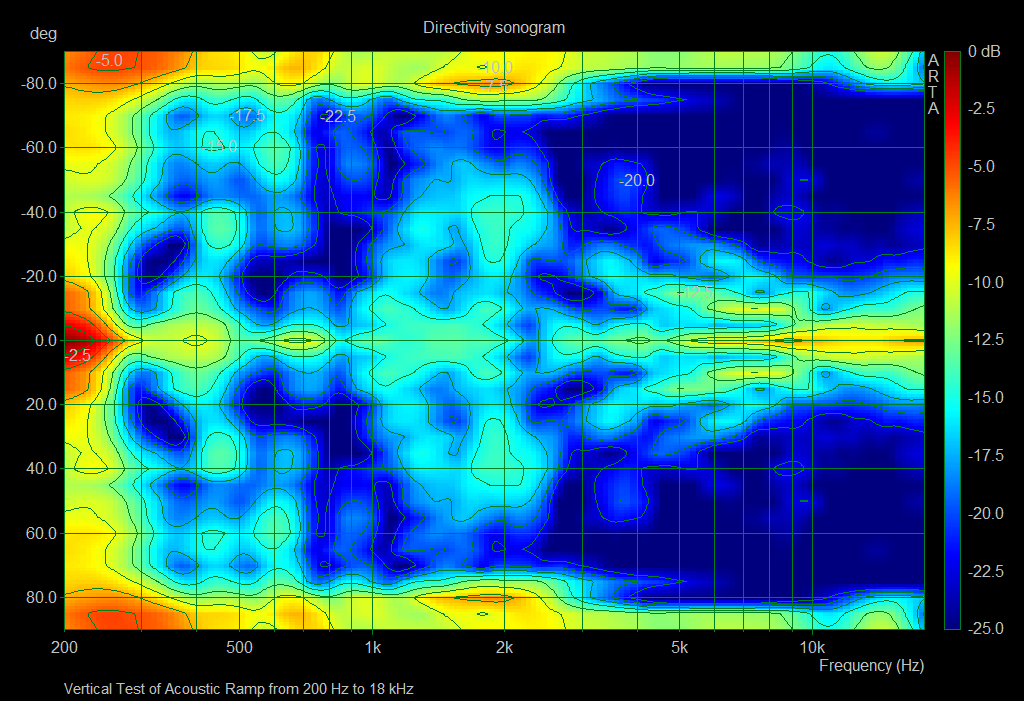“People had significant trouble hearing speakers in our church sanctuary, while carrying on a conversation in our social hall was nearly impossible. Hendrik Gideonse was able to improve both significantly. Now instead of complaints, all I hear is, “It’s so much better!” Poor sound can exclude people, and we are grateful now to be much more inclusive.” — Rev. Susan Milnor, Interim Minister, Unitarian Universalist Church of Medford, MA
The Unitarian Universalist Church in Medford, MA has an a beautiful newly renovated room called Benker Hall. The space is used both by the church for social activities and by renters who use the space for rehearsals, meetings and performances. There is a nice sized stage, a wonderful stained glass window, and beautiful visible beams and trusses holding up the cathedral ceiling.
Unfortunately there is a serious problem with the acoustics. The room is so reverberant that is is extremely difficult to understand speech. The long echoes in the room blur the clarity of consonants and make listening to music difficult and frustrating. As you might imagine, the ability to understand a speaker or properly enjoy music is a critical requirement for the room if it is to fulfill its intended purpose. The room is 40 feet across and 32 feet tall. The following photos are from Benker Hall:
In order the quantify the problems with intelligibility, we performed acoustic testing to evaluate the length of the reverberation and to describe the problems created by the room’s echoes. The following data was generated using impulse response testing:
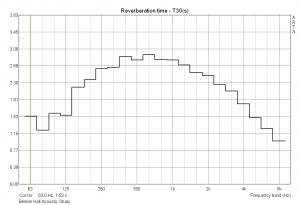
SPEECH TRANSMISSION INDEX - MTF Matrix
---------------------------------------------------------------------
Band 125 250 500 1000 2000 4000 8000
---------------------------------------------------------------------
0.63 0.9300 0.8481 0.7895 0.7970 0.8467 0.8968 0.9618
0.80 0.8962 0.7855 0.7054 0.7143 0.7786 0.8458 0.9398
1.00 0.8615 0.7273 0.6280 0.6373 0.7123 0.7931 0.9146
1.25 0.7962 0.6320 0.5003 0.5088 0.5939 0.6922 0.8583
1.60 0.7429 0.5665 0.4055 0.4148 0.4973 0.6039 0.7991
2.00 0.7074 0.5247 0.3383 0.3436 0.4198 0.5294 0.7407
2.50 0.6909 0.4827 0.2804 0.2629 0.3296 0.4398 0.6583
3.15 0.6941 0.4374 0.2458 0.2278 0.2442 0.3492 0.5600
4.00 0.6646 0.4049 0.2044 0.2019 0.1996 0.2687 0.4540
5.00 0.6204 0.4042 0.1719 0.1498 0.1670 0.1977 0.3473
6.30 0.6054 0.3831 0.1406 0.1319 0.0955 0.0834 0.2310
8.00 0.5187 0.3389 0.1101 0.1210 0.0606 0.0265 0.1343
10.00 0.5007 0.2945 0.0517 0.0856 0.1097 0.1063 0.1433
12.50 0.4775 0.1447 0.1221 0.1456 0.1166 0.1527 0.1898
---------------------------------------------------------------------
OctTI 0.6354 0.5002 0.3748 0.3813 0.3963 0.4338 0.5657
---------------------------------------------------------------------
STI = 0.4330 (male), 0.4327 (female) Rating: POOR (POOR)
(%ALcons= 13.5135)
The church purchased 45 2″ thick 24″x48″ acoustic absorbers. I installed the panels with a bunch of church volunteers. As the panels went up on the walls, the acoustic response of the room steadily improved. When completed the room was significantly quieter, meaning the room was not amplifying speech as much. The reverb time was reduced audibly, but the real change was in the nature of the reverberation. The ambiance of the room was cleaner, less distracting and simpler. Older congregants and those with hearing loss were extremely enthusiastic about the improvements.
The following after “after” photos:
The testing procedure was repeated with the following results:
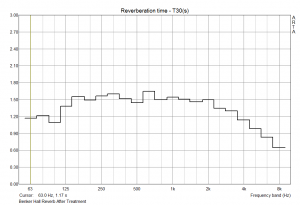
SPEECH TRANSMISSION INDEX - MTF Matrix
---------------------------------------------------------------------
Band 125 250 500 1000 2000 4000 8000
---------------------------------------------------------------------
0.63 0.9530 0.9113 0.9332 0.9303 0.9480 0.9674 0.9890
0.80 0.9271 0.8644 0.8978 0.8930 0.9196 0.9487 0.9823
1.00 0.8985 0.8141 0.8595 0.8523 0.8882 0.9275 0.9742
1.25 0.8383 0.7137 0.7826 0.7688 0.8222 0.8809 0.9550
1.60 0.7810 0.6230 0.7129 0.6899 0.7583 0.8332 0.9329
2.00 0.7316 0.5442 0.6546 0.6203 0.7008 0.7880 0.9094
2.50 0.6776 0.4501 0.5872 0.5380 0.6309 0.7283 0.8740
3.15 0.6424 0.3880 0.5202 0.4689 0.5698 0.6655 0.8301
4.00 0.6288 0.3679 0.4591 0.4097 0.5308 0.6095 0.7849
5.00 0.6059 0.3441 0.4264 0.3430 0.5076 0.5672 0.7458
6.30 0.5641 0.2547 0.4060 0.2983 0.4974 0.5452 0.7124
8.00 0.5374 0.1775 0.3337 0.2536 0.4872 0.5400 0.6835
10.00 0.4471 0.2118 0.3104 0.2135 0.4884 0.5295 0.6576
12.50 0.3994 0.1089 0.2940 0.2050 0.4446 0.5168 0.6511
---------------------------------------------------------------------
OctTI 0.6419 0.4937 0.5690 0.5349 0.6197 0.6726 0.7813
---------------------------------------------------------------------
STI = 0.6195 (male), 0.6274 (female) Rating: GOOD (GOOD)
(%ALcons= 5.8988)

